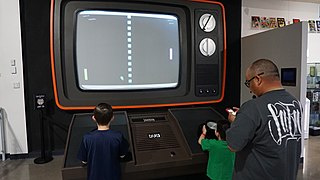
A video game is an electronic game that involves interaction with a user interface to generate visual feedback on a two- or three-dimensional video display device such as a touchscreen, virtual reality headset or monitor/TV set. Since the 1980s, video games have become an increasingly important part of the entertainment industry, and whether they are also a form of art is a matter of dispute.

The history of video games goes as far back as the early 1950s, when academic computer scientists began designing simple games and simulations as part of their research or just for recreative purpose. At M.I.T. in the 1960s, professors and students played games such as 3D tic-tac-toe and Moon Landing. These games were played on computers such as the IBM 1560, and moves were made by means of punch cards. Video gaming did not reach mainstream popularity until the 1970s and 1980s, when video arcade games and gaming consoles using joysticks, buttons, and other controllers, along with graphics on computer screens and home computer games were introduced to the general public. Since the 1980s, video gaming has become a popular form of entertainment and a part of modern popular culture in most parts of the world. One of the early games was Spacewar!, which was developed by computer scientists. Early arcade video games developed from 1972 to 1978. During the 1970s, the first generation of home consoles emerged, including the popular game Pong and various "clones". The 1970s was also the era of mainframe computer games. The golden age of arcade video games was from 1978 to 1982. Video arcades with large, graphics-decorated coin-operated machines were common at malls and popular, affordable home consoles such as the Atari 2600 and Intellivision enabled people to play games on their home TVs. During the 1980s, gaming computers, early online gaming and handheld LCD games emerged; this era was affected by the video game crash of 1983. From 1976 to 1992, the second generation of video consoles emerged.
The video game crash of 1983 was a large-scale recession in the video game industry that occurred from 1983 to 1985, primarily in the United States. The crash was attributed to several factors, including market saturation in the number of game consoles and available games, and waning interest in console games in favor of personal computers. Revenues peaked at around $3.2 billion in 1983, then fell to around $100 million by 1985. The crash abruptly ended what is retrospectively considered the second generation of console video gaming in North America.
The video game industry is the economic sector involved in the development, marketing, and monetization of video games. It encompasses dozens of job disciplines and its component parts employ thousands of people worldwide. As of 2018, video games generated sales of US$134.9 billion annually worldwide.
An online game is a video game that is either partially or primarily played through the Internet or any other computer network available. Online games are ubiquitous on modern gaming platforms, including PCs, consoles and mobile devices, and span many genres, including first-person shooters, strategy games and massively multiplayer online role-playing games (MMORPG). In 2019, revenue in the online games segment reached $16.9 billion, with $4.2 billion generated by China and $3.5 billion in the United States.

A mobile game is a game played on a mobile phone, tablet, smartwatch, PDA, portable media player or graphing calculator. The earliest known game on a mobile phone was a Tetris variant on the Hagenuk MT-2000 device from 1994.
A PC game, also known as a computer game or personal computer game, is a type of video game played on a personal computer rather than a video game console or arcade machine. Its defining characteristics include: more diverse and user-determined gaming hardware and software; and generally greater capacity in input, processing, video and audio output. The uncoordinated nature of the PC game market, and now its lack of physical media, make precisely assessing its size difficult.In 2018, the global PC games market was valued at about $27.7 billion.
Independent video game development, or indie game development, is the video game development process of creating indie games; these are video games, commonly created by individual or small teams of video game developers and usually without significant financial support of a video game publisher or other outside source. These games may take years to be built from the ground up or can be completed in a matter of days or even hours depending on complexity, participants, and design goal.

The relationship between women and video games has received extensive academic and media attention. Since the 1990s, female gamers have commonly been regarded as a minority, but industry surveys have shown that over time, the gender ratio has become closer to equal, and since the 2010s, women have been found to make up around half of all gamers. Sexism in video gaming, including sexual harassment, as well as underrepresentation of women as characters in games, is an increasing topic of discussion in video game culture.
A casual game is a video game targeted at a wide, mass market audience, as opposed to a hardcore game, which is a game targeted at a more niche audience of hobbyist gamers. Casual games may exhibit any type of gameplay and genre. They generally have simpler rules, shorter sessions, and less learned skill than hardcore games.

The video game industry in mainland China currently is one of the major markets for the global industry, where more than half a billion people play video games. Revenues from China make up around 25% of nearly US$100 billion video game industry as of 2018, and since 2015 has exceeded the contribution to the global market from the United States. Because of its market size, China has been described as the "Games Industry Capital of the World" and is home to some of the largest video game companies. China has also been a major factor in the growth of esports, both in player talent and in revenue.
The United Kingdom is Europe's second largest video game market after Germany and the fifth largest in the world. The UK video game market was worth £5.7 billion in 2018, a 10% increase over the previous year. From this, £4.01 billion was from the sales of software, £1.57 billion from the sales of hardware, and £0.11 billion from the sales of other game related items. In the software market, the data showed a significant increase in digital and online revenues, up +20.3% to a record £2.01bn. £1.17 billion of software sales came from mobile games. In 2017, the number of players was estimated at 32.4 million people.

Video gaming in the United States is one of the fastest-growing entertainment industries in the country. According to a 2010 study released by the Entertainment Software Association, the computer and the video game industry added $4.9 billion to the economy of the United States. There are some estimates that by 2015 the worldwide gaming industry will possibly reach $70.1 billion.
In South Korea, video games are considered to be a major social activity, with most of the games being cooperative or competitive. Locally developed Role-playing games, FPS, MMORPG and Mobile games have proven to be very popular in the country. Professional competition surrounding video games also enjoy a substantial following in South Korea—major tournaments are often broadcast on television and have large prizes available.

Google Play, formerly Android Market, is an American digital distribution service operated and developed by Google. It serves as the official app store for devices running on "Google certified" Android operating system, allowing users to browse and download applications developed with the Android software development kit (SDK) and published through Google. Google Play also serves as a digital media store, offering music, books, movies, and television programs. It previously offered Google hardware devices for purchase until the introduction of a separate online hardware retailer, Google Store, on March 11, 2015, and it also offered news publications and magazines before the revamp of Google News on May 15, 2018.
The video game industry is a relatively young sector in Nigeria. As of 2015, the video game development sector is still very small in the country, with only half a dozen young companies creating games. However, in part due to the country's fast growing mobile market and its young population, video games are rapidly growing in popularity.
The relationship between race and video games has received substantial academic and journalistic attention. Game theory, based on Johan Huizinga's Homo Ludens, argues that playing video games provides a way to learn about the world. Games offer opportunities for players to explore, practice, and re-enforce cultural and social identities. Video games predominantly created and played by one racial group can unintentionally perpetuate racial stereo-types and limit players' choices to preconceived notions of racial bias.
Video gaming in Finland consists of video game industry of 260 active video game developer studios, roughly a dozen professional players and countless enthusiastic amateurs.
The Tehran Game Convention exhibition is a video game conference being held by Iran Computer and Video Games Foundation in partnership with Game Connection. The convention is slated to be Iran's first business to business-approached international event in the field of video games.
Video gaming in Indonesia is a growing sector, holding the 16th largest market in the world and about half the Southeast Asian market in 2017. Over 40 million people in the country are active gamers, with mobile gaming being the dominant sector in terms of revenue. The development of video games in the country began with imported consoles and arcade centers, prior to developments of online gameplay in PC games and increasing prevalence of the internet cafés. Mobile games began gaining importance as smartphones were introduced.






